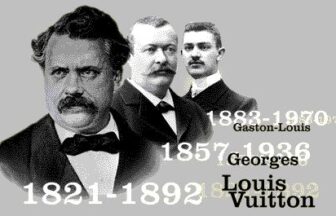Louis Vuitton’s iconic “Monogram” dates back to 1896, when Georges Vuitton, the son of founder Louis Vuitton, created it. At the time, the brand was already renowned for its high-quality travel trunks, but its success also led to a surge in counterfeit products. To protect the brand’s identity and combat the rise of imitation goods, Georges saw the need for a distinctive symbol. Thus, the Monogram pattern, combining flowers, stars, and the “LV” initials, was born.
The Design and Influences of the Monogram
The Monogram design is heavily influenced by the Art Nouveau style, which was popular in the late 19th and early 20th centuries. Art Nouveau is known for its use of natural forms, curved lines, and floral motifs. The flowers and star shapes in the Monogram are a reflection of this artistic trend, showing that Georges Vuitton was influenced by the aesthetic sensibilities of the time.
There is also a widespread belief that the Monogram design was inspired by Japan’s “kamon” (family crests). Kamon, which have been used for centuries in Japan, are symbolic emblems representing families or clans. Their geometric and symmetrical designs are simple yet powerful, and aesthetically pleasing. It’s said that Georges Vuitton was inspired by these traditional Japanese symbols when he created the Monogram during an era when Japan was becoming a cultural fascination in Europe.
However, there is no official documentation from Louis Vuitton that directly confirms this link between the Monogram and Japanese kamon. Most historians and design experts attribute the Monogram’s creation primarily to the influence of Art Nouveau. Additionally, the intricate Monogram pattern was specifically designed to make it difficult to replicate, providing a functional defense against counterfeiters.
The Connection Between “Japonism” and the Monogram
In the latter half of the 19th century, France experienced a cultural phenomenon known as “Japonism.” This movement reflected the growing admiration for Japanese art and culture, particularly in the realms of visual art, design, and fashion. French artists and designers were captivated by the clean lines, simplicity, and elegance of Japanese aesthetics, especially seen in ukiyo-e prints, ceramics, and textiles. It is possible that Georges Vuitton, living in this era of Japonism, was influenced by Japanese design elements and incorporated them into his work.
Although the theory of the Monogram being inspired by kamon is not strongly supported by historical evidence, it is an intriguing possibility. There are visual similarities between the Monogram and certain Japanese crests, but whether this was a deliberate influence or a coincidence remains unclear.

Japanese Kamon
The Evolution of the Monogram and Its Impact Today
Louis Vuitton’s Monogram has endured over time, continuing to symbolize the brand’s identity. It is used not only on bags and wallets but also on accessories, clothing, and a variety of luxury products. Its timeless appeal remains intact, and it continues to evolve through collaborations with contemporary artists and designers. These collaborations breathe new life into the Monogram, allowing it to remain modern while retaining its classic allure.
The Monogram represents more than just craftsmanship and innovation; it is also a unique fusion of Eastern and Western design influences. Regardless of whether its origins are fully understood, the Monogram has solidified its place as a fashion icon and is beloved by people worldwide.
The creation of Louis Vuitton’s Monogram was driven by practical needs to protect the brand from counterfeiting, but its design also reflects the artistic movements of the time, particularly Art Nouveau. While there is speculation that the Monogram was influenced by Japanese kamon, there is no concrete evidence to support this claim. However, considering the popularity of Japonism in late 19th-century France, it is possible that Georges Vuitton was inspired by Japanese culture to some extent.
Ultimately, the Monogram is a symbol that transcends time and trends. Its rich history and cross-cultural aesthetic have made it a cornerstone of the Louis Vuitton brand, representing both tradition and modernity in the world of luxury fashion.







